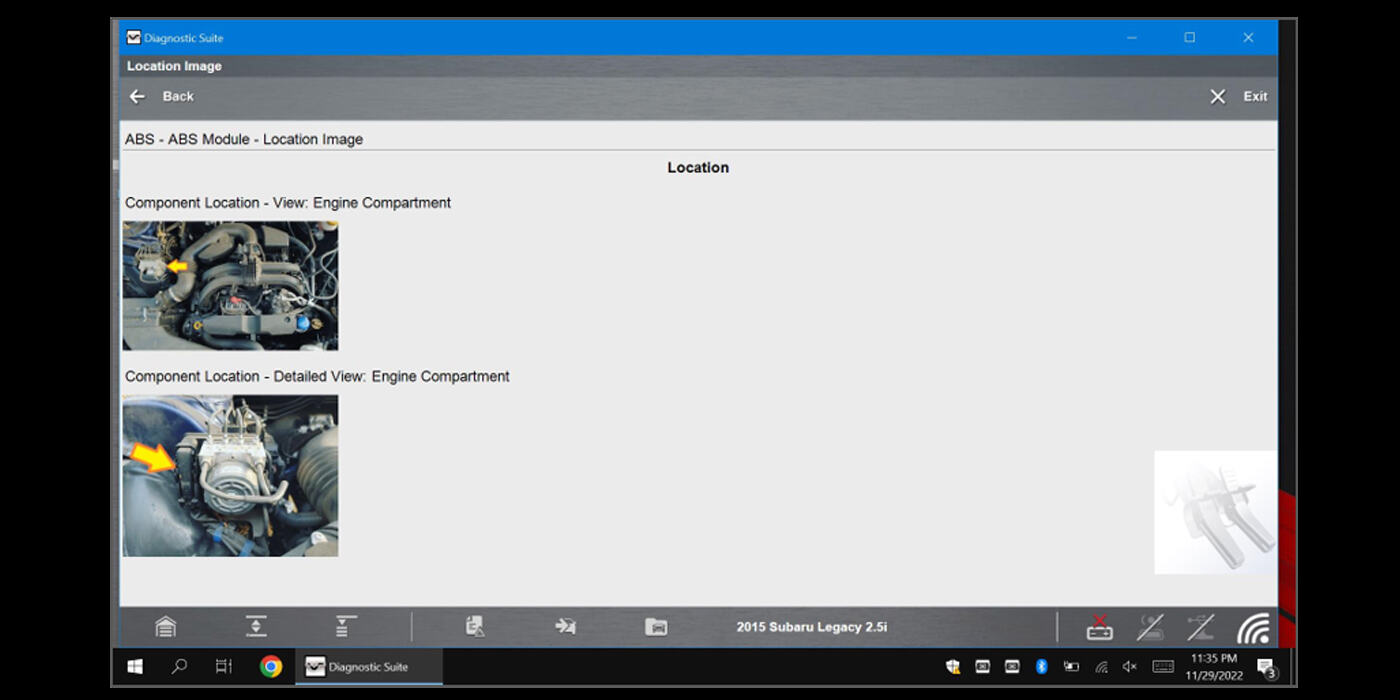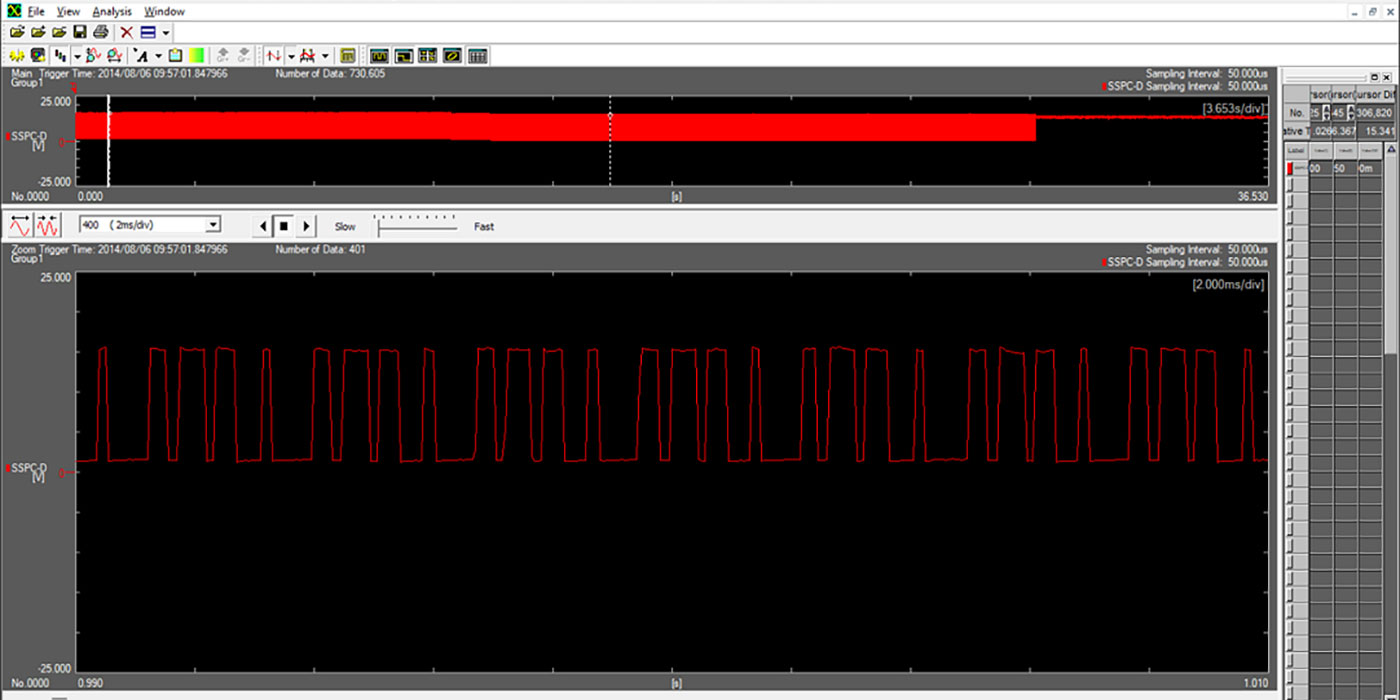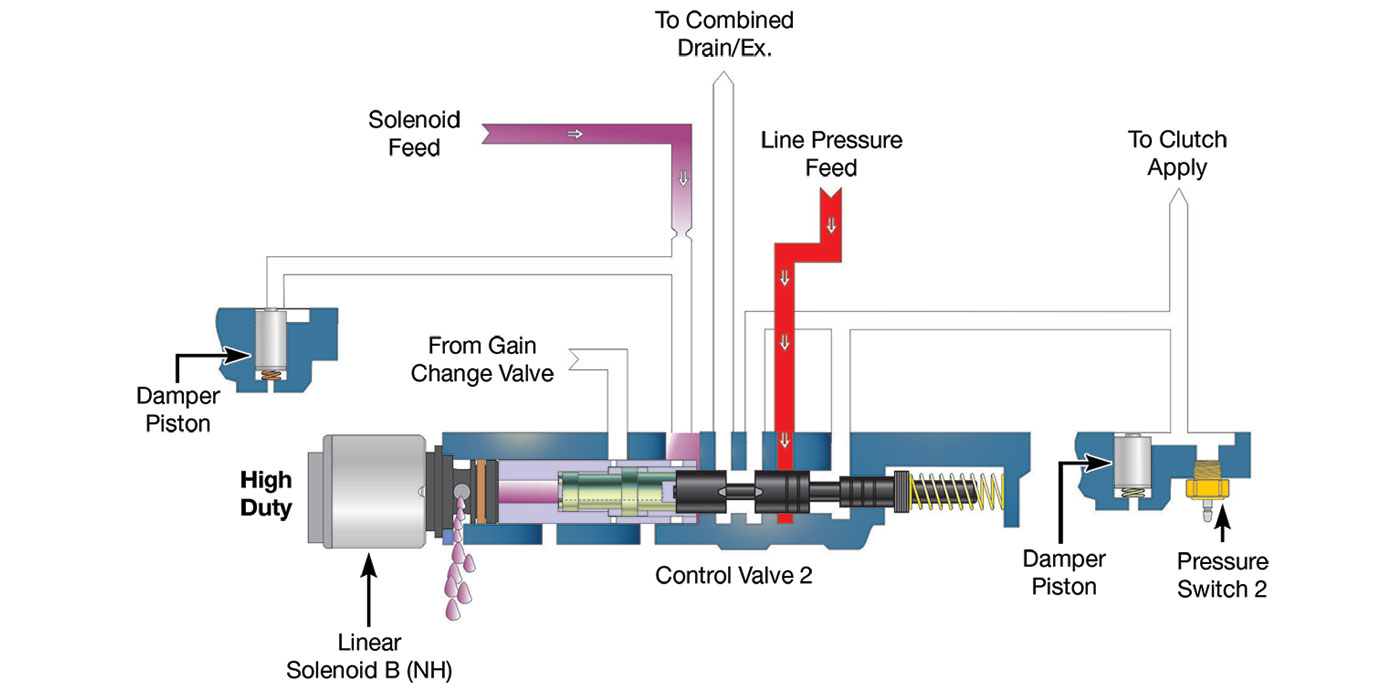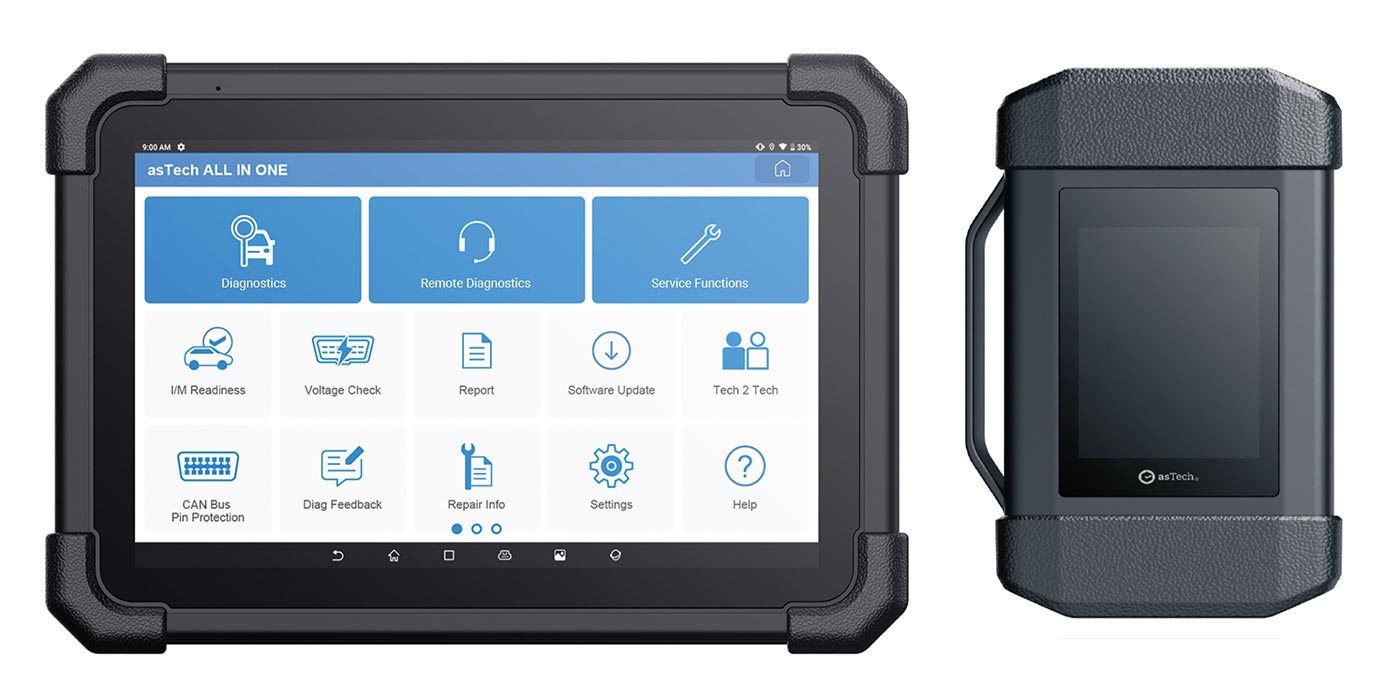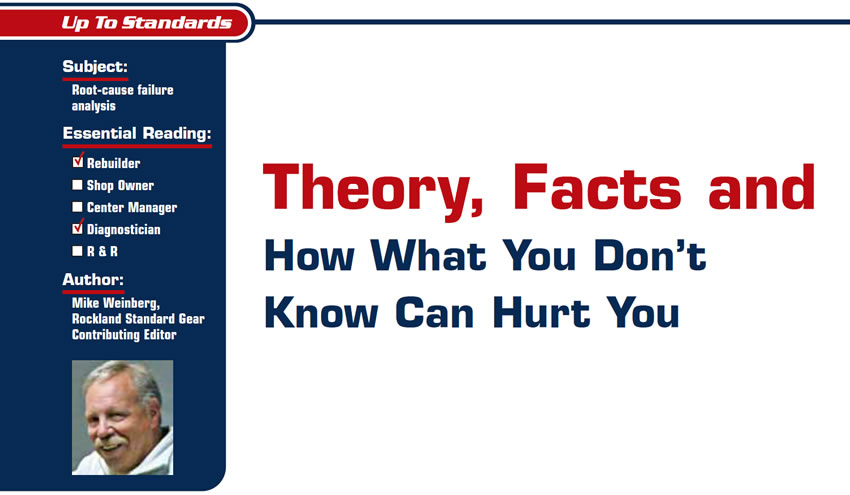
Up to Standards
- Subject: Root-cause failure analysis
- Essential Reading: Rebuilder, Diagnostician
- Author: Mike Weinberg, Rockland Standard Gear, Contributing Editor
To start this off with a bang, transmission repair is now an outdated term. Sure, you work on transmissions, but in reality you are working on a motor vehicle. This vehicle has an engine, a transmission, a driveline, a suspension, brake system, cooling system etc.
In other words, you are dealing with a very complex group of components that are all related. Any flaw or failure in one of these component systems can have a dramatic effect on other related parts. For instance, a bad radiator or failed water pump can immediately cause damage to the engine, an automatic transmission or the HVAC system. If you repair the transmission without repairing the cooling system, the transmission will fail again in short order. Why? Because the original transmission failure was an effect and not the cause of the problem.
If you do not remove the cause of the problem, nothing else you do will be more than a waste of time. This is called root-cause failure analysis and is the difference between success and failure in any type of repair business. To be successful in pleasing and therefore retaining your customer base (staying in business), it is critical that you be able to sort through all the effects (failed parts) and sort out the root cause. If you do not find the root cause, all the new parts you put in to fix the effects will fail again, leaving you with wasted labor and the need to buy new parts without being able to charge the customer again.
Every design has inherent flaws. These flaws are, for the most part, removed during prototype testing by the manufacturer in real-world simulated conditions. For instance, the manufacturer outsources most of the parts content of the vehicle. The carmaker contracts with a transmission manufacturer to design and build a six-speed manual transmission for a specific model. The transmission manufacturer submits a design that is refined, accepted and then made into a prototype for actual testing.
The transmission manufacturer outsources a number of parts such as seals, bearings, synchronizer rings etc. to other manufacturers, and all these parts will go through rigorous testing to make sure they meet the expected design criteria. This involves testing for noise, adequate torque levels, shift feel and durability. A lot of the testing will be to the point of destruction of the parts to establish a level of durability.
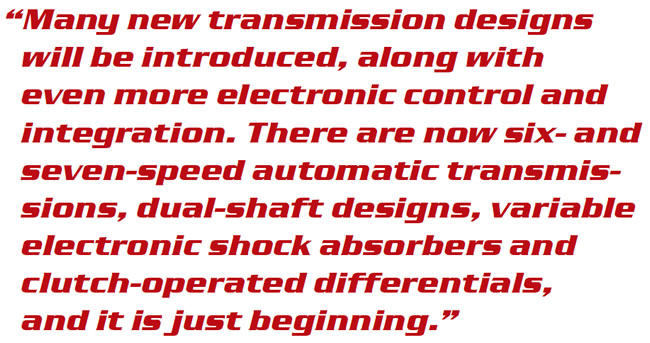
An example might be that when the manufacturer of the synchronizer rings provides sample product, it does so in several thousand rings. The transmission manufacturer will set up a test stand in which the transmission will be shifted by machine under the full torque load for perhaps a million cycles. The machine will run until the number of desired shifts is achieved or there is a failure. In short, for a part to be validated by the car manufacturer to be used in its vehicle, the manufacturer of the part will spend a great amount of money in design, development and testing before it ever gets to turn a profit from the parts.
One of the reasons our industry continues to decline and consolidate is that no one is building a bad car today. The pressure on the suppliers to produce quality components is severe, and as a result we have much-longer durability periods to contend with. Transmissions that used to have a life expectancy of 75,000 miles now routinely work well for 125,000 miles. Coupled with longer warranty periods and aggressive dealer-service programs, this puts us into the fight of our business lives to continue to exist.
The most-valuable commodity is not gold, diamonds or material things. Knowledge is the most-valuable commodity, and with proper knowledge you can acquire all the material things. Knowledge of vehicle repair (complex related systems) starts with theory. Understanding the theory of operations is the only key to successful repair. There is no need to concern yourself with where the parts go, as there are manuals to show you. With the advent of digital cameras it would be easy to document the parts sequence on any transmission without a manual and successfully put it back together.
You will never be able to diagnose a problem correctly or do a correct root-cause failure analysis unless you understand the operation of the component and its relationship to other components and systems. There is always the shotgun approach, where we just throw parts at it until something gets better, or you can replace the unit with a reman assembly and hope the problem goes away. If the problem is external to the gearbox, you still have the problem, but less money in your bank account to worry about.

Having been on the tech lines for decades, I have heard it all. There is the call that starts with, “I have put three different reman units in this truck and the transfer case still does not work right; do you have a good rebuilt we can buy?”
I start by asking whether all three units are doing the same thing as the original problem, in which case it becomes obvious that the original problem is outside the transfer case. What are the odds of three different reman units all having the same problem as the original unit? It is also obvious that the caller has no understanding of the theory of operations of the vehicle he is working on, and when his core got returned to the provider of the first unit there was probably little wrong with it.
In many instances the caller is frustrated by the pressure he is feeling from his customer and the expense he has committed to with no good results and will try to “kill the messenger.” I have been told many times that I don’t know what I am talking about and have been called many choice names. If the guys on the tech line don’t know what they are doing, how do they stay in business, and why are you calling them? After you let the caller vent his wrath for a few minutes, it easier to give him the education he badly needs. Yes, mismatched tires can cause all sorts of transfer-case problems. No, you cannot drive this transfer case in 4WD on dry pavement without it binding up. Yes, a bad transmission MLPS can cause the transfer case not to function.
There are facts you need to know or have reference materials available to access, such as diagnostic trouble codes or wiring diagrams, clearances, endplay etc. Then there is the theory of operation, which will encompass all transmissions, all transfer cases, all clutches and all differentials. They all function in basically the same manner, no matter what differs in appearance or design.
Look at basic theory that is easily misunderstood. Let’s take endplay specifications as a starting point. What is endplay and why is it important? Endplay is defined as the amount of front-to-back movement of the internal components of a transmission or transfer case. All modern transmissions are equipped with helical-cut gears for quiet operation. The greater the helix of the gears (more angle), the greater the thrust load they will exert on the case under torque. In other words, the gears will try to walk away from each other under power and will contract into each other on coast.
When most transmissions were made with cast-iron cases and used ball bearings for shaft support, endplay was not a major consideration. Why? Because cast iron expanded with operational heat about the same amount as the gear train, and the spacing stayed fairly constant internally. When transmission cases began to be made of aluminum and magnesium to save weight, the designs also incorporated tapered roller bearings for shaft support. Tapered bearings were able to bear up under greater thrust loads but were very vulnerable to incorrect endplay spacing.
Since aluminum and magnesium expand much differently from the steel gears, and to compensate for differences in manufacturing tolerances, the tapered bearings needed to be shimmed to establish a cold endplay measurement. As an example, if we shim the transmission gear set to zero endplay with zero preload (shaft-turning effort) on the bench, what will we have during operation in the vehicle? Due to expansion of the cases from operating temperatures, and the thrust loads from the engine torque, your endplay probably will run from 0.002 to 0.005 inch during operation. Whenever specifications the manual gives you for a particular unit, they will be designed to give you the proper clearances under operating conditions. Too much clearance on endplay will result in noise issues, gear jump-out and increased wear on the components. Too little clearance will result in excess internal temperatures, an increase in parasitic drag loss and exaggerated wear on the thrust surfaces. It does not matter which transmission you are working on, automatic or stick; for proper operations and good durability the endplay must be set correctly.
Another misunderstood theory involves lubrication. At one time virtually every standard transmission was designed to run on 90-weight gear lube. Manufacturers began to receive tons of complaints about cold-shift problems, where the units would not shift without a great deal of effort when cold.
The theory behind this is the way that a synchronizer operates. The synchronizer ring is a “wet” clutch, which when pressed onto the cone of the speed gear during a shift will slow down or speed up the speed gear until its speed matches that of the input gear and a smooth shift occurs. Ninety-weight gear oil in cold temperatures gets thick and will not exhaust from under the synchro ring. If the ring is sliding on a film of oil, it cannot regulate the speed of the speed gear and you get very stiff, high-effort shifts until the unit warms up.
In current technology we no longer use 90-weight in any modern transmission. The lubricant is designed and specified to be compatible with the type of compound used in the synchronizer rings. We now have paper-lined rings, carbon-fiber rings, sintered-metal-alloy rings and a host of new product being developed. The specified lube will ensure maximum function of the synchro rings, and any substitute will create shift problems and excess wear. Some of these lubes are expensive, but saving money by using something else will be really costly. Any synchro-ring material that is porous and absorbs the wrong lube will take forever to purge that material and may require replacement of the rings (think costly).
We find that the greatest lack of understanding at present involves transfer cases. Because of the large volumes present in the market and the fact that transfer cases are found behind all types of transmissions, the need to be clear on how they operate and integrate with other vehicle systems is vital. The engine, transmission, ABS, stability and traction control, and differentials are all integrated into the four-wheel- or all-wheel-drive operations.
To find the root cause of any failure, you will have to access all the powertrain, drivetrain and body computers for trouble codes. Tire size and pressure, wheel-speed sensors, wiring faults, differentials, lift kits, vehicle modifications of any type and driver operation will all influence transfer-case operation.
The beginning of any diagnosis involves certain questions: How is it supposed to function and operate? Are all outside influences operating correctly? Has the driver read and understood the operating manual, or is he trying to make the systems operate in a manner they weren’t designed for? Is the damage we find the result of a failure or the cause of the failure?
Fixing results works only when we locate and remove the cause. If we know the theory of how it operates, we then can work to find where the root cause is. If you don’t know how it is supposed to work, what chance do you have of being successful?
We are about to enjoy the largest amount of change in vehicle design in this decade. Many new transmission designs will be introduced, along with even more electronic control and integration. There are now six- and seven-speed automatic transmissions, dual-shaft designs, variable electronic shock absorbers and clutch-operated differentials, and it is just beginning. Understand transmission theory and who cares whether it is a two-speed Powerglide or a six-speed ZF? They all will have the basic theory of operations. Instead of one planetary, there will be two or three. There will still be a need to create hydraulic pressure through a pump to apply sets of clutches or bands to hold and release various parts of the planets to achieve different gear ratios, and forward and reverse. Instead of a vacuum modulator there is a variety of electric solenoids that apply components and modulate line pressure in line with throttle opening and wheel speed. It isn’t new, there is just more of it, and it is all tied into related systems so that you must understand vehicle-repair theory and not transmissions as your only focus.
The next big question is, “How do you learn the theory?” All this depends on you and your commitment to yourself. It takes some intelligence, a curious mind, persistence and a desire to be the best at what you do. There are magazines, books and manuals, and a vast amount of information to be found on the Internet. All professional fields require ongoing education, because the only constant in life is change. Lawyers, doctors, accountants, insurance agents, real-estate agents etc. will always have to continue with their education to keep up with the changes that take place every day in their fields.
If you consider yourself a professional then you must be prepared to make time to read and keep up with the operation of the new technology. You need to decide – on the basis of your ability to learn and your desire to earn more – how much time you need to put into this. There isn’t much on TV that you will miss if you set aside some time every day to expand your knowledge. If you don’t make the effort, the changes will happen so fast you will be on the outside looking in very quickly. On the other hand, a technician who is really comfortable with the theory of operations will be very comfortable with the changes as they occur and will have a good earning capacity anywhere in the world.











